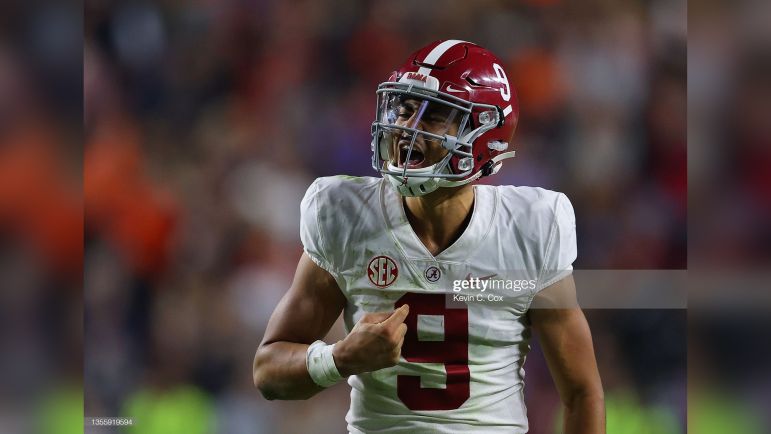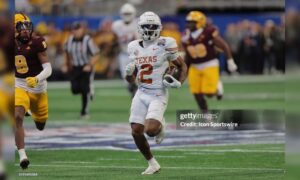Today I wanted to look at quarterback prospects in the upcoming draft, a position room that the Pittsburgh Steelers need to fill with depth, likely in the late rounds or undrafted pool. The graph below uses their 2022 PFF Grade and their current rank on PFF’s Big Board that updates through the draft process:
The top overall player on PFF’s current big board is Alabama’s Bryce Young, who played the most snaps the last three seasons in 2021 (831), with just 109 in 2020 and 666 last year. He graded very well in 2022 with 90+ overall, passing, intermediate, deep, and no pressure grades, and a great 67.5 pressure grade. Young had a strong 77.4 adjusted completion rate that tied for 15th in college football last season, 5.7% big-time throw rate (T-50th), 749 deep yards (60th), 8.2% drop rate, 3.02 average time to throw (T-153rd), an average depth of target of 10 (T-56th), 2% turnover worthy play rate (T-18th), 194 screen yards (123rd), and a great 12.5% pressure to sack conversion rate. Statistically, his 2021 season was stronger in more playing time, with 365 completions on 550 attempts (66.4 completion percentage) for 4,860 yards, a 47/7 touchdown to interception ratio, and a 117.4 passer rating, compared to 245 completions on 380 attempts (64.5 completion percentage) for 3,325 yards, a 32/5 TD/INT ratio, and a 114.9 passer rating last year. Young was a Combine invite, and a concern is his small stature (5101, 204).
Kentucky’s Will Levis lands at number four on the current board and played the most in 2021 (766 snaps) with 177 previously and 698 in 2022. He had the second worst overall grade last year (68.6) along with poor passing, intermediate, deep, and no pressure grades, and an above-average mid-50 pressure grade. Levis had a good 75.6 adjusted completion percentage (T-34th), 2.3% big-time throw rate (156th), 541 deep yards (T-113th), 7.5% drop rate, 2.58 average time to throw (T-54th), 8.6 average depth of target (T-108th), 3.6% turnover worthy play rate (T-98th), 342 screen yards (57th), and a 26.8% pressure to sack conversion rate. He largely had a better statistical season in 2021, with 232 completions on 352 attempts (65.9 completion rate) for 2,827 yards, a 24/13 TD/INT ratio, and a 97.8 passer rating, compared to last year when he had 186 completions on 286 attempts (65% completion rate) for 2,416 yards, a 19/10 TD/INT ratio, and slightly improved passer rating (99.1). Levis was a Senior Bowl invite that didn’t participate, and was at the combine, showing arm talent that teams are intrigued by.
Ohio State’s C.J. Stroud is fifth on the board, and played 700+ snaps the last two seasons (754, 734), with only seven in 2020. Last year, he had upper 80 overall and passing grades, 90+ deep and no pressure grades, a slightly below average intermediate grade, but a poor 43.9 pressure grade. Stroud had a 72.8 adjusted completion percentage (T-73rd), 7% big-time throw rate, a strong 1,082 deep yards (17th), 5.9% drop rate, 2.92 average time to throw (T-137th), 10.7 average depth of target (T-31st), 3.6% turnover worthy play rate (T-98th), 224 screen yards (109th), and a 14.1% pressure to sack conversion rate. His stats were stronger in 2021, with 317 completions on 443 attempts (strong 71.6 completion rate) for 4,424 yards, a 44/6 TD/INT ratio, and an impressive 130.8 passer rating, compared to 257 completions on 390 attempts (65.9 completion rate) for 3,684 yards, a 41/6 TD/INT ratio, and another great passer rating of 125. Stroud was a Combine participant and had a strong workout that impressed many evaluators.
Florida’s Anthony Richardson lands at the next spot on PFF’s current list, with most of his experience the last three seasons coming in 2022 (767 snaps), compared to just 195 and six the prior two years. In 2022, he had a low 80 overall grade, 90+ deep grade, mid-80 intermediate and no pressure grades, a below-average low 70 passing grade, and a poor 41.9 pressure grade. Richardson had a 64.1 adjusted completion percentage (160th), 5.5% big-time throw rate (T-55th, a strong 1,000 deep yards (24th), 7.4% drop rate, 3.18 average time to throw (163rd), healthy 11.5 average depth of target, 3.3% turnover worthy play rate (T-70th), 154 screen yards (138th), and a strong 9.2% pressure to sack conversion rate, highlighting elusiveness along with the value he provides as a runner. He had 175 completions on 330 attempts (53% completion percentage) for 2,553 yards, a 17/9 TD/INT ratio, and an 84.3 passer rating last season. Richardson had a historical combine athletically, with the potential to become a dual-threat very attractive in today’s NFL.
The first player that would start day two of the draft on PFF’s current board is Stanford’s Tanner McKee, who had the most snaps in the last three years in 2022 (791, 587, 12). He had mid-70 overall and passing grades, a 90+ deep grade, mid 80 no pressure grade, but a poor intermediate grade, and a slightly below average 47.5 pressure grade. McKee had a 72 adjusted completion percentage (T-83rd), 3.3% big-time throw rate (T-136th), 478 deep yards (128th), 6.4% drop rate, 2.51 average time to throw (35th), 7.8 average depth of target (T-140th), a strong 1.5% turnover worthy play rate (T-7th), 347 screen yards (53rd), but a 27% pressure to sack conversion rate. His stats were a bit mixed the last two years, with 206 completions on 315 attempts in 2021 (65.4 completion rate) for 2,325 yards, a 15/7 TD/INT ratio, and his best passer rating (93.9), compared to 265 completions on 433 attempts (61.2 completion rate) for 2,949 yards, with a worse 13/8 TD/INT ratio and 83.8 passer rating. McKee was a Combine participant with great size for the position.
Tennessee’s Hendon Hooker saw an increased workload each of the last three seasons (760, 673, 445). In 2022, he had 90+ overall, deep, and no pressure grades, a mid 80 passing grade, mid 70 intermediate grade, but below average 43.7 pressure grade. Hooker had a good 75.9% adjusted completion percentage (T-31st), 4.6% big-time throw rate (T-84th), impressive 1,219 deep yards (11th), 6.9% drop rate, 2.6 average time to throw (T-60th), a healthy 11.7 average depth of target (T-ninth), a fantastic 1.1% turnover worthy play rate that tied for second in college football, 363 screen yards (49th), but a high 29% pressure to sack conversion rate. His production increased in many ways, including completions (229, 207, 98), attempts (331, 304, 153), completion percentages (69.2, 68.1, 64.1), yards (3,135, 2,948, 1,343), and impressively low interception totals (two, three, five), but had a dip in touchdowns (27, 31, nine) and passer rating (123.9, 129.1, 98). Hooker was a Senior Bowl invite despite coming off an ACL injury and was at the Combine and was encouragingly cleared medically for the upcoming NFL season.
Purdue’s Aidan O’Connell is outside PFF’s top 100 and saw more opportunities each of the last three years (808, 632, 224). In 2022, he had mid 60 overall (lowest of the group) and passing grades, low 70 intermediate, deep, and no pressure grades, and a slightly below-average 48 pressure grade. O’Connell had a 73 adjusted completion percentage (T-68th), 4% big-time throw rate (T-109th), 546 deep yards (109th), 6.5% drop rate, 2.5 average time to throw (T-31st), 8.3 average depth of target (T-127th), 4.4% turnover worthy play rate (T-135th), 344 screen yards (55th), and a 16.3% pressure to sack conversion rate. His production was better in 2021, with 314 completions on 438 attempts (strong 71.7 completion rate) for 3,709 yards, a 28/11 TD/INT ratio, and 108 passer rating, compared to 318 completions on 499 attempts (63.7 completion rate) for 3,483 yards, a 22/13 TD/INT ratio and an 88.1 passer rating on more snaps last season. O’Connell was a Shrine Bowl participant, and thought he struggled in the game with a couple of poor decisions including a near pick, noted a couple of accuracy issues as well, but did complete a nice back shoulder throw for a third down conversion, and was also a combine invite.
Next, I would like to look at players that are day three options on PFF’s current big board that had above the mean grades. Fresno State’s Jake Haener saw the most snaps the last three seasons in 2021 (835) compared to 440 previously and 521 in 2022. Last year, he had upper 80 overall and passing grades, 90+ intermediate, deep, and no pressure grades, but a below-average 45.7 pressure grade. Haener had a great 78.8 adjusted completion percentage (tenth), 4.3% big-time throw rate (T-94th), 577 deep yards (101st), 5.6% drop rate, 2.67 average time to throw (T-74th), 8.7 average depth of target (T-104th), a good 2.2% turnover worthy play rate (T-22nd), 263 screen yards, but a poor 21.5% pressure to sack conversion rate. His production aligned with his opportunities as expected, providing 330 completions on 490 attempts in 2021 (67.3 completion rate) for 4,098 yards, a 33/9 TD/INT ratio, and 107.8 passer rating, compared to 253 completions on 355 attempts (improving to a nice 71.3 completion rate) for 2,900 yards, with a 20/3 TD/INT ratio, improving the latter which aided his best passer rating in the span (110.8, 107.8, 103.4). Haener was a Senior Bowl participant and played a ton in the game, starting the game off well with nice throws including one on the run placing it away from the defender, then had several accuracy issues in my notes that far outweighed the good, and was a combine invite of smaller stature (5115, 207).
Georgia’s Stetson Bennett had increased snaps each of the last three years (784, 500, 368). In 2022, he had 90+ overall, intermediate, deep, and no pressure grades, an upper 80 passing grade, and good 60.8 pressure grade. Bennett had a good 76.3 adjusted completion percentage, 5.9% big-time throw rate (T-42nd), nice 998 deep yards (25th), 5.8% drop rate, 2.53 average time to throw (38th), 9.4 average depth of target (T-82nd), good 2.4% turnover worthy play rate (T-28th), a high 633 screen yards (ninth), and a 12.2% pressure to sack conversion rate. His production increased in many ways, including completions (309, 184, 86), attempts (454, 288, 158), completion rates (68.1, 63.9, 54.4), and yards (4,132, 2,861, 1,174), with a dip in touchdowns (27, 29, eight) and improved in interceptions considering more playing time last year (seven, seven, six). Bennett declined his invite to the Senior Bowl, then participated at the combine with more and quality athletic testing than several at the position, but has concerning size (5113, 192).
Houston’s Clayton Tune saw increased opportunities as well (863, 759, 519), and had the highest 92 overall grade of the bunch in 2022. He paired this with 90+ passing, intermediate, deep, and no pressure grades, along with a solid 67.7 pressure grade. Tune had a great 79.5 adjusted completion percentage (seventh), 5.8% big-time throw rate (T-46th), a solid 1,022 deep yards (21st), 8.5% drop rate, 3.2 average time to throw (165th), 9.7 average depth of target (T-67th), 3% turnover worthy play rate (T-50th), with a high 691 screen yards (sixth), and a 16.7% pressure to sack conversion rate. His production increased with playing time, including completions (333, 288, 170), attempts (496, 425, 287), yards (4.065, 3,542, 2,040), touchdowns (40, 30, 15), and passer rating (110.7, 107, 84), but a dip in completion percentage (67.1, 67.8, 59.2) and had ten interceptions in each season. Tune was a Senior Bowl participant and had a good game in my opinion, making a multitude of positive plays including the “little things” such as selling play action (a nice throw on one that included a boot to the left), making good throws/decisions under pressure, eluding a free rusher for a nice scramble, and the only negative in my notes a throw that was tipped and almost picked. He also had a strong Combine workout, another puzzle piece that’s intriguing.
BYU’s Jaren Hall didn’t play in 2020, followed by 680 snaps, then 782 last season. He had a mid-80 overall grade, 90+ deep and no pressure grades, low 80 passing grade, below average mid-70 intermediate grade, and a poor 41.1 pressure grade. Hall had a 75.9 adjusted completion percentage (T-31st), 5.5% big-time throw rate (T-55th), 937 deep yards (T-33rd), 4.3% drop rate, 2.78 average time to throw (T-107th), average depth of target of 10 (T-56th), 2.7% turnover worthy play rate (T-37th), 448 screen yards (32nd), and an 11.9% pressure to sack conversion rate. His production largely improved the last two seasons as expected, including completions (247, 189), attempts (376, 296), completion rates (65.7, 63.9), yards (3,162, 2,583), touchdowns (31, 20), and passer rating (112.7, 107.1) with a slight uptick in interceptions as snaps increased (six, five). Hall was a Senior Bowl participant the seemingly fared well during the week, and showed off athleticism at the combine but is smaller statured (6001, 207).
A late-round prospect on PFF’s current big board with a below-average grade is Malik Cunningham of Louisville, who had 558 snaps last year, compared to 779 and 729 the prior two seasons. In 2022, he had low 70 overall and no pressure grades, an upper 60 intermediate grade, a low 60 passing and deep grades, and a poor 41.4 pressure grade. Cunningham had a 69.4 adjusted completion percentage, 3% big-time throw rate, 298 deep yards, 4.9% drop rate, 3.02 average time to throw, 9.2 average depth of target, 3.2% turnover-worthy play rate, 140 screen yards, but a 21.2% pressure to sack conversion rate. 2021 was largely the best season of production, when he had 209 completions on 342 attempts (his lowest 61.1 completion rate though) for 2,949 yards, a 19/6 TD/INT ratio, and a 100.1 passer rating, compared to 136 completions on 218 attempts (62.4 completion rate) for 1,567 yards, an 8/5 TD/INT ratio and his lowest 86.7 passer rating of the last three years in 2022. Cunningham was a Senior Bowl participant with many positives in my game notes, starting with several good scrambles including a sneak for a touchdown (though the snap was botched), along with a play action pass for a two-point conversion, along with a few good throws, with two negatives being a poor read to keep on an RPO, and most notably a pick-six. He showcased his speed at the combine, though is another small prospect (5116, 192).
Tyson Bagent didn’t appear on the chart due to PFF not grading his school (Shepard), landing at 266 on the board. He got a ton of playing time in the Senior Bowl, starting the game off well and made some good throws, then struggled near the goal line with a couple of poor ones including a near interception, was inaccurate downfield, and was a mixed bag under pressure taking a sack, stepping into pressure on a couple of occasions, but did have a good throw as he was hit and also had a bad interception under pressure as well. Bagent was also a Combine participant and tested well overall.
Two players remain who are late-round/undrafted possibilities, starting with UCLA’s Dorian Thompson-Robinson who saw an increase in opportunity the last three seasons (804, 763, 324). In 2022, he had mid-70 overall, intermediate, and no pressure grades, an upper 60 passing grade, a poor mid-60 deep grade, and an average 49.5 pressure grade. Thompson-Robinson had a great 77.4 adjusted completion percentage (T-15th), 2.8% big-time throw rate (T-149th), 521 deep yards (118th), 5.3% drop rate, 2.8 average time to throw (T-114th), an average depth of target of seven (T-158th), 4.1% turnover worthy play rate (T-125th), 346 screen yards (54th), and an 11% pressure to sack conversion rate. His production improved in many ways last season, including completions (266, 175, 91), attempts (384, 284, 140), completion percentage (69.3, 61.6, 65), yards (3,159, 2,390, 1,128), touchdowns (27, 21, 12), and passer rating (106.7, 104.3, 106.5), with the exception being more interceptions each year (ten, six, four). He was a Shrine Bowl participant, with our own Melanie Friedlander noting he was the best at the position during the week (a low bar though), and Josh Carney seeing him as a late/undrafted Steelers candidate. He saw a lot of action in the game with an up-and-down performance, starting with a near pick on a screen, a few accuracy issues including overthrows and a pass break up, indecisive/late on a couple of others and a poor throwaway on a third down, with positives including a few good throws particularly under pressure and a couple over the middle, a fumble recovery, and a good run block. He was another prospect that showcased speed at the Combine but was small (6015, 203).
The final player at the position on PFF’s current big board is TCU’s Max Duggan, who had several snaps the last three years (752, 606, 629). In 2022, he had an above-the-mean 83 overall grade, 90+ deep and no pressure grades, a mid-70 passing grade, a low 70 intermediate grade, and below average 45.7 pressure grade. Duggan had a 74.2 adjusted completion percentage (T-55th), 4.8% big-time throw rate (T-79th), a great 1,372 deep yards (sixth), 7.9% drop rate, 2.8 average time to throw (T-114th), 9.7 average depth of target (T-67th), 3% turnover worthy play rate (T-50th), a high 618 screen yards (11th), and an 18.5% pressure to sack conversion rate. His production largely improved each season: completions (267, 145, 145), attempts (420, 228, 242), completion rates (63.6, 63.6, 59.9), yards (3,697, 2,040, 1,802), touchdowns (32, 16, 10), interceptions (eight, six, four), and passer ratings (109.2, 104.8, 89.9). Duggan got a lot of playing time in the Senior Bowl, mostly positive including a few nice throws, one to the sideline, a great laser over the middle against zone to convert a fourth down, and another on an end zone target, and was also good at eluding pressure a couple of times, but did have a few accuracy issues as well, one under pressure, off target over the middle, and most notably an overthrow in the end zone. His combine was also impressive in the speed department and is also on the small side (6014, 207).
It will be interesting to see how the position room unfolds for the Steelers, and if any additions are made in the 2023 NFL draft. While the ranks on PFF’s board will certainly change, and surely some names missing from this list, I hope you enjoyed and learned something from the grade data and notes from the all-star games.
What are your thoughts on this year’s prospects and the data? Thanks for reading and let me know your thoughts in the comments.









